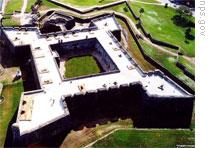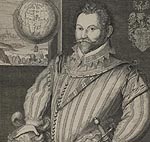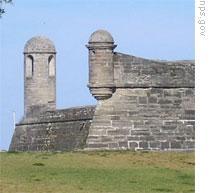VOA慢速英语 2008 1203b
时间:2019-01-11 作者:英语课 分类:VOA慢速英语2008年(十二)月
This is Steve Ember.
VOICE TWO:
And this is Shirley Griffith with the VOA Special English program EXPLORATIONS. Our story today tells of ships, explorers, pirate 1 attacks and wars.
It is the story of an old military base, the Castillo de San Marcos. It was built in the oldest permanent European settlement in the United States -- Saint 2 Augustine, in the southern state of Florida.
(MUSIC)
VOICE ONE:

Castillo de San Marcos
To reach the Castillo de San Marcos you must drive through part of the city of Saint Augustine. Saint Augustine is in northeastern Florida near the Atlantic Ocean.
You drive on a small, narrow road with vehicles slowly going both ways. On one side of the road is water. On the other side is the city.
You pass businesses, eating places, stores and hotels. And then you see it, just as the road turns to the left. It looks like a hill of rock rising out of the ground. It seems fierce. And it looks very foreign. There can be no mistake about what it is. It is a very old military base -- the kind that is called a fort 3. It looks like it should be in some European country, not on the coast of Florida.
VOICE TWO:
Near the entrance is an area to leave your car. A large sign says "National Park Service, Castillo de San Marcos." In English the name means the "Castle of Saint Mark."
A National Park Service worker sells us a ticket to enter the old fort. It only costs a few dollars. Slowly we make our way across a wide, water-filled area called a moat.
VOICE ONE:
Passing through the huge walls of the fort is a little like walking back in time. Sounds from the street and the city of Saint Augustine do not reach inside. The fort is very much like it was when its builders completed most of it in sixteen ninety-five. There are ancient guns here. Most of the huge cannon 4 are made of bronze. They are a green color because of their great age. Some have deep marks showing the gun was made by the royal weapons factory in Spain. Others are British.
If you could look down at the fort from above, you would see it is shaped like a star with four large points. The fort has more than twenty rooms. Some rooms were used to store weapons, medical supplies and food. One of the rooms was used to hold religious services. Soldiers lived in others.
VOICE TWO:
The Spanish built nine forts 5 in this area before they built San Marcos. They needed some kind of strong protection after they arrived in fifteen sixty-five. That was when explorers first claimed the area for Spain. Soldiers were left there to provide protection for Spanish treasure ships sailing from the Americas back to Spain. They were also there to protect Spain's claim to Florida.

Sir Francis Drake
The first forts were made of wood. They were not very strong. One of the early ones was burned in fifteen eighty-six by the famous British sea captain, Francis Drake. The Florida heat and insects quickly destroyed other wood forts.
Spanish military officials in Florida knew they needed more protection. They asked Spain for the money to build a stronger fort. Each time they asked, however, they were refused.
The need for a stronger fort became clear on the night of May twenty-eighth, sixteen sixty-eight.
VOICE ONE:
Earlier that day, a ship sailed near Saint Augustine. The townspeople thought it was Spanish. It was not. That night, pirates 6 attacked the town and the wooden fort. The Spanish soldiers were able to keep the pirates from capturing 7 the wooden fort, but they could not protect the town.
Many people in Saint Augustine were killed or captured 9. The pirates left when they could find nothing else to steal. They destroyed much of the town.
VOICE TWO:
Spanish officials immediately began sending money to build a stronger fort. They also sent workers to Saint Augustine to replace the wooden fort with something that offered more protection.
Workers found a nearby area where they could begin cutting thick stone to build the fort. It took almost four years to gather enough money and to prepare the land for the fort. But on October second, sixteen seventy-two, Governor 10 Don Manuel de Cendoya held a special ceremony to observe the beginning of the work.
VOICE ONE:
The Castillo de San Marcos grew very slowly. It took twenty-three years to complete. There never seemed to be enough money to pay the workers. There never seemed to be enough workers. Disease 11 often struck the builders. The fierce heat of Florida's summer months slowed the work each year. The work was extremely difficult, but the new fort was finished just in time. War was soon declared.
(MUSIC)
VOICE TWO:
The year seventeen-oh-two was the first real test of the Castillo's strength. The War of Spanish Succession 12 had begun in Europe. Britain, Austria and their allies 13 were fighting Spain and France to prevent a French prince from becoming the King of Spain.
The governor of the British colony 14 of Carolina was James Moore. He hoped to capture 8 the fort to prevent a possible attack by Spanish or French forces on his British colony further up the coast. Governor Moore commanded five hundred British troops and three-hundred Indians in his invading 15 army.
The Spanish army only had two hundred thirty soldiers and one hundred eighty Indian allies at Castillo de San Marcos. Moore's army arrived with eight small ships, and blocked the harbor 16 of Saint Augustine. The people of the town fled into the Castillo.
Governor Moore could make no progress in his attack. The huge new fort was too strong. Then, several Spanish war ships arrived to help the Spanish soldiers. Moore burned his small ships and retreated 17 to the north. He burned the town of Saint Augustine before he left. But the Spanish soldiers and the people of the town had survived in the fort. The battle had lasted for fifty days.
VOICE ONE:
The Spanish again strengthened the fort after the British attack. This time they made a wall of earth around Saint Augustine to protect the town. They also improved the fort's defenses. Saint Augustine became a walled city.
In seventeen forty, the British again attacked Castillo San Marcos. For twenty-seven days they fired huge shells at the fort. The shelling had little effect. The British withdrew 18.
VOICE TWO:

Part of the fort
In seventeen sixty-three, Spain gave up its claim to Florida. The British took control. Castillo de San Marcos soon became Fort Saint Mark. The British occupied the fort during the American Revolution. When the war ended, Florida was once again returned to Spain.
Spain held Florida until eighteen twenty-one. Then, tensions 19 between Spain and the United States caused Spain to give up its claim to Florida. The name of the old fort was changed again. It was now called Fort Marion.
During the next one hundred years the fort was used as a prison to hold American Indians from the western States. It was also used as a military prison.
In nineteen twenty-four, Fort Marion was declared a national historical monument. In nineteen thirty-three, the United States War Department gave the old fort to the National Park Service. The National Park service changed its name back to Castillo de San Marcos.
(MUSIC)
VOICE ONE:
Today, the Castillo de San Marcos still seems to protect the city of Saint Augustine. However, no enemy has attacked since the year seventeen forty. Each day hundreds of people do what no enemy was ever able to do. They enter the fort.
The National Park Service representatives lead small groups of visitors through the fort. They explain how it was built. And they tell stories of the people who built it.
They also tell of pirates and English invaders 20. They explain why it was so very difficult for even a strong enemy to capture the fort. Children play near the huge old guns that are no longer dangerous. They play that they are fighting against fierce invaders.
Most visitors have cameras and take pictures. Everyone enjoys looking at the beautiful surroundings 21 from the top of the old fort's walls. Many visitors stand inside the small guard rooms at each point of the star. Inside the guard room, you can look out the little windows at the ocean, much the same way Spanish soldiers watched for enemies.
Then, for a few moments, Castillo de San Marcos may seem again to be protecting the city of Saint Augustine, and the treasure ships returning to Spain.
(MUSIC)
VOICE TWO:
This Special English program was written and produced by Paul Thompson. Our studio engineer was Holly 22 Capehart. This is Shirley Griffith.
VOICE ONE:
And this is Steve Ember. Join us again next week for another EXPLORATIONS program on the Voice of America.
- The pirate chief commanded that the prisoners should be shot.海盗头子下令枪毙俘虏。
- The shore batteries fired at the pirate boat.海岸炮兵向海盗船开火。
- The fort can not be defended against an air attack.这座要塞遭到空袭时无法防御。
- No one can get into the fort without a pass.没有通行证,任何人不得进入要塞。
- The soldiers fired the cannon.士兵们开炮。
- The cannon thundered in the hills.大炮在山间轰鸣。
- A line of forts was built along the border to protect the country against attack. 在边界沿线修筑了堡垒以保护国家免受攻击。
- Forts and churches almost always go together, and yet they're downright contradictions. 有要塞的地方,就一定有教堂,然而,这两者显然是水火不相容的。
- Children dressed (themselves) up as pirates. 孩子们假扮成海盗。 来自《现代汉英综合大词典》
- The pirates treated their captives with barbarity. 海盗们残暴地对待他们的俘虏。 来自《现代汉英综合大词典》
- Since when is capturing a felon considered interference? 从何时起抓住重案犯被认为是妨碍组员行动?
- Capturing the enemy-held towns is the pivot of our plans. 夺取敌人控制的城镇,是我们计画的轴心。
- The company is out to capture the European market.这家公司希望占据欧洲市场。
- With the capture of the escaped tiger,everyone felt relieved.逃出来的老虎被捕获后,大家都松了一口气。
- Allied troops captured over 300 enemy soldiers. 盟军俘虏了300多名敌方士兵。
- Most of the rebels were captured and disarmed. 大部分叛乱分子被俘获并解除了武装。
- The governor was an expert at fencing with reporters.这位州长是搪塞新闻记者的能手。
- He was elected governor of the state of California.他当选为加州州长。
- The doctors are trying to stamp out the disease.医生正在尽力消灭这种疾病。
- He fought against the disease for a long time.他同疾病做了长时间的斗争。
- He gave forth a series of works in rapid succession.他很快连续发表了一系列的作品。
- His succession as headmaster was not in any doubt.他继任校长是确定无疑的。
- The allies would fear that they were pawns in a superpower condominium. 这个联盟担心他们会成为超级大国共管的牺牲品。
- A number of the United States' allies had urged him not to take a hasty decision. 美国的一些盟友已力劝他不要急于作决定。
- There lived a colony of bees on the tree.树上生活着一群蜜蜂。
- They live in an artists'colony.他们住在艺术家聚居区。
- The invading troops were guilty of rape and pillage. 侵略军犯了抢劫和强奸的罪。 来自《简明英汉词典》
- The invading army desecrated this holy place when they camped here. 侵略军在这块圣地上扎营就是对这块圣地的亵渎。 来自《简明英汉词典》
- The harbor lies to the south of the city.港口在城市的南边。
- At that time,our ship was tied up at this harbor.当时我们的船停靠在这个港口。
- He always retreated emotionally at the first whiff of conflict. 只要有一点冲突的迹象,他在感情上就退缩。
- He retreated hastily back to his car. 他匆忙退回自己的车里。
- She withdrew to confer with her advisers before announcing a decision. 她先去请教顾问然后再宣布决定。 来自《简明英汉词典》
- She quickly withdrew her hand from the hot iron. 她很快地将手从火烫的熨斗上缩了回来。 来自《简明英汉词典》
- Social tensions were manifested in the recent political crisis. 最近的政治危机显示了社会关系的紧张。
- These disagreements are symptomatic of the tensions within the party. 出现意见分歧表明该党内部的关系紧张。
- They prepared to repel the invaders. 他们准备赶走侵略军。
- The family has traced its ancestry to the Norman invaders. 这个家族将自己的世系追溯到诺曼征服者。
- She is not very well tuned into her surroundings. 她不太适应周围的环境。
- The rich man lives in luxurious surroundings.这位富人生活在奢侈的环境中。